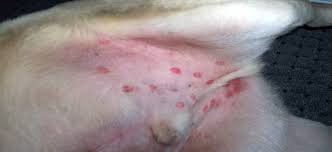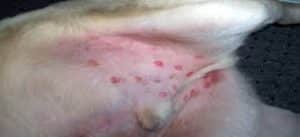
Although poison ivy poisoning is not as common in dogs as it is in humans, once it occurs it can have devastating effects. Poison ivy on dogs fur may not have much effect if it doesn’t penetrate deep into the skin. However, areas with no fur or those covered by a thin layer of it are quite vulnerable. Once the poison ivy sap gets into contact with skin, the result is contact dermatitis. Even worse is when your dog ingests the sap. If not dealt with immediately, the effects will be severe. Find out the symptoms to look out for, available treatments and when to see your veterinarian.
Contents
Poison Ivy on Dogs
Poison ivy, referred to as Toxicodendron Radicans, is a woody vine known to produce urushiol; a toxic resin. The urushiol oil containing sap is found in every part of the plant; the roots, leaves, and stem. Once the poison gets into contact with the skin, there is a reaction and the skin itches severely. With time the poison ivy on dogs skin will cause rashes. If these are not taken care of blistering and formation of sores may occur.
The poison ivy plant grows in most parts of the United State and can be identified by its distinctive three leaf structure and bright green color as seen below. They can grow as trailing vines on the ground or climbing vines trailing on trees. They also grow in clusters forming shrubs. It easily grows in the backyard, in fields, streams, wetlands, parks, and even the roadside.
The plants are easy to break exposing the pets to the sap. The fact that dogs love to roll over and run when outdoors makes it easy for them to get in contact with the oil. Other plants with the same kind of reaction are poison oak and sumac. The extent of the reaction becomes more severe with repeated and concentrated exposure.
The areas with hair are protected from the negative effects of poison ivy on dogs as it will only get on the fur. However, exposed areas and areas with thin hair like the belly, groin area, paws, ears, inner legs, armpits, and muzzle are vulnerable. Even at a greater risk of facing the wrath of poison ivy are dogs bred with short hair.
Can Dogs Get Poison Ivy in Their Mouth
Dogs love nibbling at things and there is no telling if they will want to investigate poison ivy with their mouth. In case a dog ingests poison ivy, it will experience an irritated and inflamed mouth and throat. In addition, it will also develop severe gastrointestinal problems and become extremely sick.
Can Dogs Get Poison Ivy in Their Eyes
The eyes and areas around them are vulnerable to poison ivy especially when a dog is rolling. In cases where you are dealing with poison ivy on dogs eyes or any other part of the face, it is important to keep flashing it with water and seek professional help immediately.
Symptoms of Poison Ivy in Dogs
If the oily sap is not allowed to soak into the skin, it will have no effects. However, any direct contact that the poison ivy sap gets into the dog skin will result in your dog suffering contact dermatitis. This results in symptoms such as:
- Skin inflammation and swelling
- Itching and scratching
- Licking, biting and biting at the point of contact
- Raised red patches which may blister and drain.
- Development of open sores with time
Where it is ingested, the poison ivy in dogs symptoms will include
- vomiting
- diarrhea
- anaphylactic shock
Here is a poison ivy rash on dog’s belly picture to help identify the symptoms further:

Diagnosis
In most cases, diagnosis of poison ivy on dogs poisoning is based on exposure history and a manifestation of the symptoms. According to vetary.com, the rash may take a few days to erupt and may resemble rashes caused by other contact dermatitis reactions. It is for this reason that immediate bathing is recommended once you suspect exposure.
Poison Ivy on Dogs Treatment
As soon as you realize you are dealing with poison ivy on dogs, you should take action. Avoid petting your dog as this will transfer the oil deeper while exposing your skin to it too. Prepare to give your dog a bath immediately.
- Use a mild shampoo and warm water to wash off the resin residue. This should be done when wearing gloves as if the residue gets on your skin it could cause a reaction
- Rinse off with as much water as it takes to get off the shampoo and oil off the coat of your dog.
- Give your dog a second bath using while still using the shampoo to increase the chances of eliminating all the oil.
- Once done, wipe your dog and clean the towels used promptly.
The urushiol oil is easily transmitted from the dogs to humans as well as to other dogs and surfaces. It is therefore advisable to clean up anything your pup may have come into contact with before the bath. Also, when in the process of cleaning your dog, ensure they do not shake as by so doing they will be transferring the sap.
To help relieve the itch and swelling, you could follow up the cleaning by offering some antihistamine. In case this does not help and your dog still experiences dermatitis, see your vet. They may recommend topical or oral anti-inflammatory or antihistamine infections.
CAUTION: If you suspect that your dog may have consumed the plant, seek immediate attention from your veterinarian.
Poison Ivy on Dogs Prevention
The best way to protect your pooch from the terrible effects poison ivy on dogs has is to ensure your they do not venture into areas with the plant. When walking your dog, get to know the fauna and flora present. In case you are in unfamiliar areas, prevent the dog from accessing such areas by putting them on a leash.
Poison ivy on dogs is caused by the release of antihistamines. To prevent the reaction, you could offer your dog antihistamines such as Claritin or Benadryl to curb the allergic reaction. They can be administered prior to potential exposure
Poison Ivy Dog Costume
Additionally, reducing the risk of poison ivy on dogs can be done by using a dog t-shirt or sweater to cover up. This will minimize the chances of exposure. The focus of the costume should be on the abdominal and groin areas.
Mild cases of poison ivy on dogs tend to clear up on their own. Recovery occurs without further problems. However, in case the poisoning extends to the formation of blisters, they may get infected if not well taken care of. Take proper care of your dog to prevent this.
If living in areas with a high concentration of the plant, poison ivy on dogs recurrence is likely. Learn how to avoid areas with the plant when on walks. If necessary, have your dog’s access to areas with the plant restricted. Remember to always seek professional help whenever in doubt or when you have concerns about your dog’s well being.
References
- Vetary.com: Poison Ivy Poisoning in Dogs
- Reference.com: How do you Treat Poison Ivy around the Eye?
- Thespruce.com: Getting Rid Of Poison Ivy, Oak, and Sumac on Pets
- Vetstreet.com: What Pet Owners Should Know About Poison Ivy, Oak, and Sumac

Be the first to comment